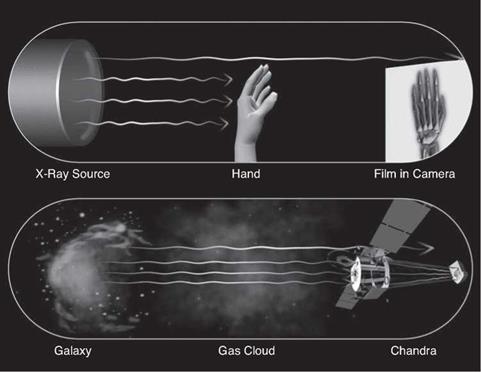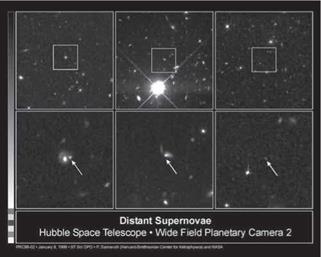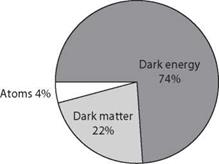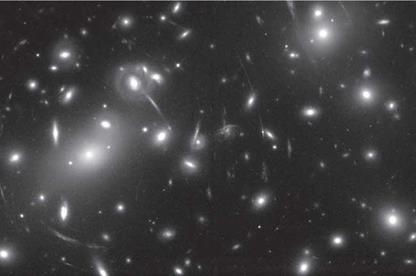The Cosmic Distance Scale
What is the science yield from this premier facility, and how has it changed our view of the universe? In the early years of a space telescope, there’s often a concerted effort to put a lot of time into a few critical projects, so that major results will be obtained even if the telescope fails. There’s understandable tension involved in this decision, since the Hubble has always been oversubscribed by a large factor, and it keeps more astronomers happy if the time is thinly spread among many projects. Riccardo Giacconi, the first director of the Space Telescope Science Institute, was persuaded to set aside substantial time for peer-reviewed “Key Projects.” Early in the history of the facility, three of these were approved. Two of them were successful but are not well known—a medium – deep survey of galaxies,35 and a spectroscopic survey of quasars to probe the hot and diffuse gas in the intergalactic medium36—but the third is rightly considered one of the Hubble Space Telescope’s finest achievements.
As we saw in the chapter on Hipparcos, distance is fundamental to astronomy, yet it’s one of the hardest things to measure. In the everyday world we judge distance based on familiarity with the size of a tree or a person, for example, or the brightness of a lamp or a street light. But in the universe, objects like stars and galaxies range over many orders of magnitude in size and brightness, so their apparent size or brightness is a very unreliable guide to distance. Is that a bright object far away or a dim object nearby? Is that a large object far away or a small object close by? This type of confusion is common. Considered in a different way, poorly determined distances limit our knowledge of how the universe works. Without knowing how far away an object is, we don’t know its true size or its true brightness. That also means we don’t know its mass or luminosity, which means we can’t have a real physical understanding of something that’s so remote that we’ll never be able to study it in the lab or gather a sample of it. This urge to measure distances accurately becomes acute in the study of the universe as one entity. In an expanding universe, precise distances are needed to answer fundamental questions: what is the size of the universe and how old is it?
Early in the life of the Hubble telescope, hundreds of orbits were devoted to measuring distances to three dozen galaxies. Fittingly, this Key Project used the method that Edwin Hubble had used in the early 1920s to show that the Andromeda nebula was a remote stellar system. Hubble identified examples of a well-known class of variable stars in M31, the Cepheid variables. Cepheids pulsate in a well-understood and well-regulated way, and this behavior manifests as a linear relationship between their luminosity and their period of variation.37 By finding Cepheids in a remote galaxy and measuring their periods with a series of images taken over hundreds of days, the star’s absolute and apparent brightness can be combined to derive the distance. Cepheids are very luminous and can be seen to large distances. But they’re buried in dense regions of overlapping star images so the sharp imaging of a telescope in space is needed to pick them out. Wendy Freedman, Rob Ken – nicutt, and Jeremy Mould led the project, accompanied by twenty – five other astronomers from around the world.
The Key Project had a goal of measuring the distance scale to an accuracy of 10 percent. This might seem unduly modest, but it’s a reflection of the difficulty of the experiment. In the decade leading up to the launch of Hubble, astronomers had disagreed by 50 percent or more on the distance scale. In particular, the goal was to measure a quantity called the Hubble constant to within 10 percent. The Hubble constant is the current expansion rate of the universe, measured in units of kilometers per second per Megaparsec. Hubble discovered a linear relation between the distance and the recession velocity of a galaxy. The Hubble constant sets that scaling. So if the Hubble constant is 70, then for every Megaparsec (3.3 million light-years) increase in distance, the recession velocity increases by 70 kilometers per second (157,000 mph). On average, this scaling says that a galaxy a million light-years away is receding from the Milky Way at 47,000 mph, a galaxy 10 million light – years away is receding at 470,000 mph, and so on. Inverting the Hubble constant allows us to project the expansion back to zero separation of all galaxies, and so gives us a good estimate of the age of the universe. By measuring distances out to 20 Megaparsecs (or 66 million light-years), the Key Project would determine the size, expansion rate, and age of the universe.
The formal result of the Key Project was the measurement of a current expansion rate of 73 kilometers per second per Megaparsec, with a random error of 6 and a systematic error of 8, published in the twenty-eighth paper in the series from team members, which indicates just how productive and prolific one Hubble project can be.38 Synching the distance scale in this way has been a foundation stone in the emergence of “precision cosmology,” where overall attributes of the universe are becoming very well-determined. Although the Key Project worked in our cosmic “back yard,” or the local 0.01 percent of the visible universe, it leveraged and helped to improve distance measurements both inward and outward. Hubble also was able to measure parallaxes for Cepheids in the Milky Way (along with Hipparcos, which we’ve previously discussed) and tether the distance scale in direct geometric measures. Knowing Cepheid distances for several dozen galaxies calibrated the use of other types of distance indicators, such as supernovae and the well-defined rotation properties of galaxies, which can be used out into the remote universe.














